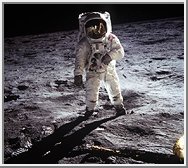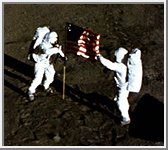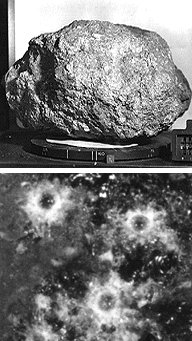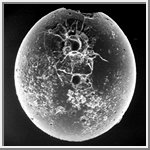 |
| Astronaut Buzz Aldrin on the surface of the Moon in 1969. [more information] |
The Great Moon Hoax
Moon rocks and common sense prove Apollo astronauts really did visit the Moon.
February 23, 2001 -- Last week my phone rang. It was my mother ... and she was upset."Tony!" she exclaimed, "I just came from the coffee shop and there's an [adjective omitted] man down there who says NASA never landed on the Moon. Everyone was talking about it ... I just didn't know what to say!"
That last bit was hard to swallow, I thought. Mom's never at a loss for words.
But even more incredible was the controversy that swirled through her small-town diner and places like it across the country. After a long absence, the "Moon Hoax" was back.
All the buzz about the Moon began on February 15th when Fox television aired a program called Conspiracy Theory: Did We Land on the Moon? Guests on the show argued that NASA technology in the 1960's wasn't up to the task of a real Moon landing. Instead, anxious to win the Space Race any way it could, NASA acted out the Apollo program in movie studios. Neil Armstrong's historic first steps on another world, the rollicking Moon Buggy rides, even Al Shepard's arcing golf shot over Fra Mauro-- it was all a fake!
Fortunately the Soviets didn't think of the gag first. They could have filmed their own fake Moon landings and really embarrassed the free world.
Shows like Conspiracy Theory ought to be as tongue-in-cheek as they sound. Unfortunately, there was an earnest feel to the Fox broadcast, enough to make you wonder if the program's makers might have fallen under their own spell.
According to the show NASA was a blundering movie producer thirty years ago. For example, Conspiracy Theory pundits pointed out a seeming discrepancy in Apollo imagery: Pictures of astronauts transmitted from the Moon don't include stars in the dark lunar sky -- an obvious production error! What happened? Did NASA film-makers forget to turn on the constellations?
Most photographers already know the answer: It's difficult to capture something very bright and something else very dim on the same piece of film -- typical emulsions don't have enough "dynamic range." Astronauts striding across the bright lunar soil in their sunlit spacesuits were literally dazzling. Setting a camera with the proper exposure for a glaring spacesuit would naturally render background stars too faint to see.
Here's another one: Pictures of Apollo astronauts erecting a US flag on the Moon show the flag bending and rippling. How can that be? After all, there's no breeze on the Moon....

|
| Neil Armstrong and Buzz Aldrin deploy a U.S. flag on the Moon in 1969. [more] |
The Fox documentary went on with plenty more specious points. You can find detailed rebuttals to each of them at BadAstronomy.com web page.
The best rebuttal to allegations of a "Moon Hoax," however, is common sense. Evidence that the Apollo program really happened is compelling: A dozen astronauts (laden with cameras) walked on the Moon between 1969 and 1973. Nine of them are still alive and can testify to their experience. They didn't return from the Moon empty-handed, either. Just as Columbus carried a few hundred natives back to Spain as evidence of his trip to the New World, Apollo astronauts brought 841 pounds of Moon rock home to Earth.
"Moon rocks are absolutely unique," says Dr. David McKay, Chief Scientist for Planetary Science and Exploration at NASA's Johnson Space Center (JSC). McKay is a member of the group that oversees the Lunar Sample Laboratory Facility at JSC where most of the Moon rocks are stored. "They differ from Earth rocks in many respects," he added.
"For example," explains Dr. Marc Norman, a lunar geologist at the University of Tasmania, "lunar samples have almost no water trapped in their crystal structure, and common substances such as clay minerals that are ubiquitous on Earth are totally absent in Moon rocks."
Fortunately not all of the evidence needs a degree in chemistry or geology to appreciate. An average person holding a Moon rock in his or her hand can plainly see that the specimen came from another world.
"Apollo moon rocks are peppered with tiny craters from meteoroid impacts," explains McKay. This could only happen to rocks from a planet with little or no atmosphere... like the Moon.
Meteoroids are nearly-microscopic
specks of comet dust that fly through space at speeds often exceeding
50,000 mph -- ten times faster than a speeding bullet. They pack
a considerable punch, but they're also extremely fragile. Meteoroids
that strike Earth's atmosphere disintegrate in the rarefied air
above our stratosphere. (Every now and then on a dark night you
can see one -- they're called meteors.) But the Moon doesn't
have an atmosphere to protect it. The tiny space bullets can
plow directly into Moon rocks, forming miniature and unmistakable
craters.
"There are plenty of museums, including the Smithsonian
and others, where members of the public can touch and examine
rocks from the Moon," says McKay. "You can see the
little meteoroid craters for yourself."

|
Left : Nick-named "Big Muley," this 11.7 kg Moon rock was the largest returned to Earth by Apollo astronauts. One side of Big Muley was peppered with meteoroid "zap pits." Below left: A close-up view of 1 mm diameter zap pits shows tiny craters lined with black glass surrounded by a white halo of shocked rock. [more] |
Just as meteoroids constantly bombard the Moon so do cosmic rays, and they leave their fingerprints on Moon rocks, too. "There are isotopes in Moon rocks, isotopes we don't normally find on Earth, that were created by nuclear reactions with the highest-energy cosmic rays," says McKay. Earth is spared from such radiation by our protective atmosphere and magnetosphere.
Even if scientists wanted to make something like a Moon rock by, say, bombarding an Earth rock with high energy atomic nuclei, they couldn't. Earth's most powerful particle accelerators can't energize particles to match the most potent cosmic rays, which are themselves accelerated in supernova blastwaves and in the violent cores of galaxies.
Indeed, says McKay, faking a Moon rock well enough to hoodwink an international army of scientists might be more difficult than the Manhattan Project. "It would be easier to just go to the Moon and get one," he quipped.
And therein lies an original idea: Did NASA go to the Moon to collect props for a staged Moon landing? It's an interesting twist on the conspiracy theory that TV producers might consider for their next episode of the Moon Hoax.
"I have here in my office a 10-foot high stack of scientific books full of papers about the Apollo Moon rocks," added McKay. "Researchers in thousands of labs have examined Apollo Moon samples -- not a single paper challenges their origin! And these aren't all NASA employees, either. We've loaned samples to scientists in dozens of countries [who have no reason to cooperate in any hoax]."
Even Dr. Robert Park, Director of the Washington office of the American Physical Society and a noted critic of NASA's human space flight program, agrees with the space agency on this issue. "The body of physical evidence that humans did walk on the Moon is simply overwhelming."
"Fox should stick to making cartoons," agreed Marc Norman. "I'm a big fan of The Simpsons!"
| Web Links |
|
BadAstronomy.com - A point-by-point rebuttal of claims in Fox's Conspiracy Theory: Did We Land on the Moon? (external site) Comments on the FOX Moonlanding Hoax special -- from the University of Arizona's Jim Scotti.(external site) |


 The Moon
The Moon